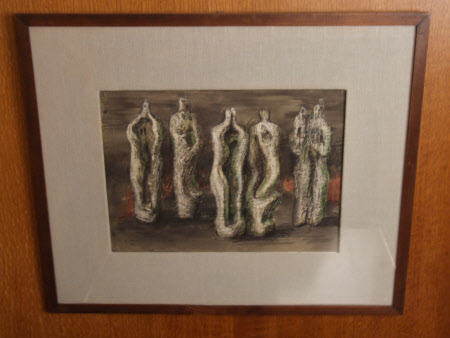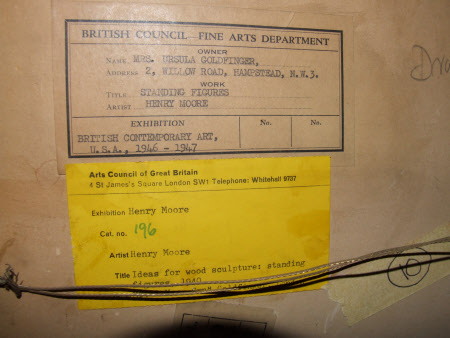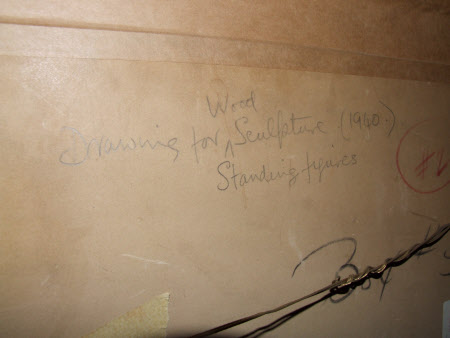Standing Figures
Henry Moore OM, CH, FBA (Castleford 1898 - Much Hadham 1986)
Category
Art / Drawings and watercolours
Date
1940
Materials
Pencil, wax crayon, charcoal, watercolour wash, pen and ink on paper
Measurements
282 x 382 mm
Order this imageCollection
2 Willow Road, London
NT 112455
Summary
Pencil, wax crayon, charcoal, watercolour wash, pen and ink on paper, Standing Figures, by Henry Moore OM, CH, FBA (Castleford 1898 - Much Hadham 1986), 1940, signed in pen and ink bottom left 'Moore / 1940'. Six anthropomorphic figures, rendered in white and grey, against a grey background with red. With exhibition labels and inscriptions on reverse (British Council and Arts Council of Great Britain).
Full description
Produced during the Second World War, 'Standing Figures’ belongs to a broad group of figural drawings originating from Moore's ‘Shelter Drawings’ of 1940-1 that ultimately informed much of his post-war sculpture. Executed on paper in a range of media – crayon, charcoal, chalk, wash, pen and ink – the drawings show anthropomorphic figures arranged both singularly and in groups, seated, standing and reclining (for more examples see Henry Moore Foundation HMF 1477, 1510, 1511, 1512, 1515, 1517, 1539a). Most are 'idea' drawings - exploratory, experimental sketches which show Moore taking different approaches to pre-existing sculptural motifs. One of the first sculptures that developed out of this material was Three Standing Figures (1947-8, Battersea Park) - a depiction of three elongated, draped human figures, each distinct yet closely related in form and posture (Henry Moore Foundation LH 268; see also the plaster models LH 258 plaster a/Tate L01768 and LH 258 plaster b). The figures suggest both connection and isolation – a recurring theme in Moore’s post-war work. The ‘Shelter Drawings’ were produced by Moore independently from 1940 and later as an official War Artist from 1941. This deeply moving series depicts the people of London taking shelter in Underground stations during the night time bombing raids of the Blitz (1940–41). Walkways, platforms and de-electrified tracks were repurposed to provide safe refuge. Observing these scenes first hand, Moore was struck by how the blankets used by civilians to warm themselves resembled protective shrouds and the drapery of classical sculpture (see HMF 1559, ‘People wrapped in blankets’, and other drawings from the First Shelter Sketchbook). In this drawing six figures stand uneasily within a barren landscape, encircled by flamelike ring (perhaps a reference to the literal fires of the Blitz). Two face each other while the others turn away, looking up and out in different directions as if scanning the skies for danger. The figures on the right appear ghostlike; the others like perforated and hollowed bones. Despite their isolated vulnerability, the grouping of the figures – their subtle turning inwards – conveys instinctual and deeply human communion. Drawing for Moore was exploratory - a process and place to develop his ideas for three-dimensional art. Indeed, it was his main outlet during the war as the conditions of war prevented him from making sculpture. According to an exhibition label on the back of the frame, the present drawing was exhibited under the title 'Ideas for wood sculpture: standing figures'. No corresponding sculpture was (or was necessarily intended to be) made. The present drawing and three other drawings (including HMF 1824a, a Shelter Drawing) were exhibited at the Aid to Russia exhibition held at 2 Willow Road in 1942. The exhibition raised funds for aid to Russia during the Nazi invasion and partial occupation and was one of the first public displays of contemporary art in a private modernist home. The Goldfingers purchased Moore’s Head (1933, NT 112757) at Aid to Russia, while HMF 1824a was purchased by Ursula Goldfinger’s half-brother, Michael Strachan.
Provenance
Exhibited at the Aid to Russia exhibition, 1942 (no. 33 at 12 guineas) and purchased there by Ernö Goldfinger and Ursula Ruth Blackwell, also known as Mrs Ernö Goldfinger; purchased by the National Trust in 1994 with support from charitable foundations and private donors.
Credit line
2 Willow Road, The Ernö Goldfinger Collection (National Trust)
Marks and inscriptions
Reverse: Drawing for Wood Sculpture (1940.) / Standing figures Reverse: An exhibition label by the British Council - Fine Arts Department for the exhibition 'British Contemporary Art, U.S.A., 1946-1947', entitled 'Standing Figures'. Reverse : An exhibition label by the Arts Council of Great Britain for the exhibition 'Henry Moore', cat.no. 196, entitled 'Ideas for wood sculpture: standing figures 1940'
Makers and roles
Henry Moore OM, CH, FBA (Castleford 1898 - Much Hadham 1986), artist
References
Garrould 1994-2003: Ann Garrould (ed.), Henry Moore: Complete Drawings, Much Hadham: Henry Moore Foundation in association with Lund Humphries, 1994-2003, vol. 3, 1940-49 (2001) Sylvester 1957: David Sylvester, Henry Moore, Volume One: Sculpture and Drawings 1921-1948, 4th edition, London 1957 Alice Correia, ‘Three Standing Figures 1945, cast c.1945–51 by Henry Moore OM, CH’, catalogue entry, January 2014, in Henry Moore: Sculptural Process and Public Identity, Tate Research Publication, 2015.


